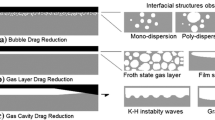Abstract
The influence of the type of gas on the performance of microbubble skin friction reduction was investigated on an axisymmetric body. Gases were selected which covered a wide range of densities and solubilities. Integrated skin friction measurements, which span a range of velocities (U ∞) from roughly 10 to 20 m/s and tunnel pressures from 1 to 2.6 atm, are presented as a function of gas flow rate. All gases show qualitatively similar behavior. The gas volume flowrate, referenced to injector ambient conditions (tunnel temperature and pressure), is shown to correlate the drag reducing behavior of all the gases at one velocity, independent of pressure. A normalization based on the volume flowrate through the turbulent boundary layer is shown to nearly collapse all the results independent of velocity or pressure. The results indicate that high ambient pressures may degrade the drag reducing capabilities of highly soluble gases.
Similar content being viewed by others
References
Bogdevich, V. G.; Evseev, A. R. 1976: Effect of gas saturation on wall turbulence. In: Investigations of boundary layer control (Eds. Kutateladze, S. S.; Migirenko, G. S.), p. 49. Novosibirsk, Siberia: Thermophysics Institute Publishing (in Russian)
Bogdevich, V. G.; Maluga, A. G. 1976: The distribution of skin friction in a turbulent boundary layer of water beyond the location of gas injection. In: Investigations of boundary layer control (Eds. Kutateladze, S. S.; Migirenko, G. S.), p. 62. Novosibirsk, Siberia: Thermophysics Institute Publishing (in Russian)
Castano, J. 1985: Microbubble drag reduction on a submerged axisymmetric body. M.S. thesis. The Pennsylvania State University
Clark, H.; Deutsch, S. 1991: Microbubble skin friction reduction on an axisymmetric body under the influence of applied axial pressure gradients. To appear in Phys. Fluids
Deutsch, S.; Castano, J. 1986: Microbubble skin friction reduction on an axisymmetric body. Phys. Fluids 29, 3590–3597
Deutsch, S.; Pal, S. 1990: Local shear stress measurements on an axisymmetric body in a microbubble modified flow field. Phys. Fluids A2, 2140–2146
Dubnishchev, Y.; Evseev, A. R.; Sobolev, V. S.; Utkin, E. 1975: Study of gas saturated turbulent streams using a laser Doppler velocimeter. J. Appl. Mech. Tech. Physics 16, 114 (translated from the Russian)
Legner, H. H. 1984: A simple model for gas bubble drag reduction. Phys. Fluids 27, 2788–2790
Lumley, J. L. 1977: Drag reduction in two phase and polymer flows. Phys. Fluids 20, S64-S71
Madavan, N. K.; Deutsch, S.; Merkle, C. L. 1984: Reduction of turbulent skin friction by microbubbles. Phys. Fluids 27, 356–363
Madavan, N. K.; Deutsch, S.; Merkle, C. L. 1985a: Measurements of local skin friction in a microbubble modified turbulent boundary layer. J. Fluid Mech. 156, 237–256
Madavan, N. K.; Merkle, C. L.; Deutsch, S. 1985b: Numerical investigations into the mechanisms of microbubble drag reduction. J. Fluids Eng. 107, 370–377
Marié, J. L. 1987: A simple analytical formulation for microbubble drag reduction. J. Phys.-Chem. Hydrodynamics 13, 213–220
McCormick, M. E.; Bhattacharyya, R. 1973: Drag reduction on a submersible hull by electrolysis. Nav. Eng. J. 85, 11–16
Merkle, C. L.; Deutsch, S. 1989: Microbubble drag reduction. In: Frontiers in experimental fluid mechanics (Ed. Gad-el-Hak, M.) pp. 291–335. Berlin Heidelberg New York: Springer
Migirenko, G. S.; Evseev, A. R. 1974: Turbulent boundary layer with gas saturation. In: Problems of thermophysics and physical hydrodynamics. Novosibirsk, Nauka (in Russian)
Pal, S.; Deutsch, S.; Merkle, C. L. 1988: Bubble characteristics and trajectories in a microbubble boundary layer. Phys. Fluids 31, 744–751
Pal, S.; Deutsch, S.; Merkle, C. L. 1989: A comparison of shear stress fluctuation statistics between microbubble modified and polymer modified turbulent boundary layers. Phys. Fluids A1, 1360–1362
Pal, S. 1989: Turbulence characteristics and bubble dynamics of a microbubble modified boundary layer. Ph.D. thesis, The Pennsylvania State University
White, F. 1974: Viscous fluid flow. New York: McGraw Hill
Author information
Authors and Affiliations
Rights and permissions
About this article
Cite this article
Fontaine, A.A., Deutsch, S. The influence of the type of gas on the reduction of skin friction drag by microbubble injection. Experiments in Fluids 13, 128–136 (1992). https://doi.org/10.1007/BF00218158
Received:
Issue Date:
DOI: https://doi.org/10.1007/BF00218158




